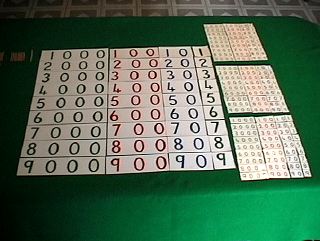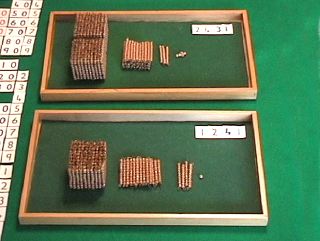Operations with the Golden Bead Material
Addition 1
NOTE:
- In addition, smaller quantities (addends) are put together to
make a larger quantity (the sum). We make the addends with small
number cards and the sum with large ones to reinforce this
understanding.
-
- In subtraction, we have a larger quantity (the minuend) from
which we subtract smaller quantities (subtrahend). Large number
cards are used for the minuend and small for the subtrahend to help
give the children this understanding. The difference is smaller
than the minuend so small number cards are used for the
difference. We use the large and small number cards in the same
way and for the same purpose in multiplication and division.
MATERIAL:
- Golden bead material consisting of units, tens, hundreds, and 9
thousand cubes
- Large number cards
- 3 sets of small number cards (These are exactly like the
large ones, only smaller.)
- 3 felt lined trays
- 2 green felt table mats
PURPOSE:
- To help children understand addition
- To learn the vocabulary involved - addition, addend, and sum
AGE:
- 4 years and older
EXERCISE
- This is a group exercise for a few children. In all the
group exercises with the golden beads, the teacher is in control.
She needs to be able to work fluently and simply. The aim is that
the children understand the process of addition. The teacher must
not be too persnickety. If she checks quantities too much and is
over-concerned with the sum, the process will be dragged out and the
children will feel uncertain. They will not enjoy the work as
much, and they will not reach the same understanding as they otherwise
would. Throughout the exercises the children will stand in front
of the work, so that they see the numerals and the arrangement of beads
right side up and in correct order. The teacher can stand at the
back.
ARRANGEMENT:
- Often one large table is used for the entire set up of the bank
games, or several small tables could be pushed together.
- The bank (golden bead material) is on the left, the number cards
in the middle, and the problems are worked on the right.
-
- The golden bead material is arranged in order on the mat. A
child is chosen to sit at this table. Her duties are to keep the
material in order and to give change as necessary. This child is
sometimes called the banker.

-
-
-
- The large number cards are laid out on another table, in columns,
so that they can all be seen. The small number cards are also
laid out so that they can all be seen. One child is in charge of
the large cards and another is in charge of the small ones. These
children keep the cards in order and hand the teacher cards as
necessary during the working of a problem. They put cards back in
place when a problem is finished. These children stand, so they
can easily reach the cards.

-
- The area on which the problems will be worked is covered with a
green mat. The teacher will stand at this table. There is a
felt lined tray for each child who will be collecting an addend.

EXERCISE:
- The teacher tells the children, "We are going to work addition
problems." The teacher will decide on a problem which will not
involve exchanging, such as, 2435 plus 1241. The teacher makes
the addends in small number cards and puts one on each of two trays.
-
- She hands a tray to each of two children, e.g. John and Jen, and
asks them each in turn to read the numeral on their tray. When
they have done so, the teacher says, "Now John, you collect two
thousand, four hundred, three tens, five and, Jen, you collect one
thousand, two hundred, four tens, one in golden beads." The
children go together to the bead table and help themselves, both at
once, to the material they need. They bring their trays back to
the teacher.

- The teacher does not check the material they have brought.
She takes a tray and while taking the material off the tray and
arranging it on the mat she says, "John, you have brought two thousand,
four hundred, three tens, five." She takes the small number
cards, "2435," off his tray and places them at the top of the
mat. She takes the second tray. While taking the quantity
off the tray and arranging it under the first she says, "Jen, you have
brought one thousand, two hundred, four tens, one." She takes the
small number cards off her tray and places them under the first ones at
the top of the mat. The small cards are placed to look like a
written problem.
-

- The teacher now draws the group's attention to the quantities on
the mat. "Here we have two thousand, four hundred, three tens,
five, and here we have one thousand, two hundred, four tens, one.
I am going to add them together. First, I will add the
units." She pushes the two quantities together as she says
this. "I will add the tens." She does so. "I will add
the hundreds. I will add the thousands." The addition is
done. Instead of two groups of golden beads, there is one group.
-

- The teacher now says, "We have added two thousand, four hundred,
three tens, five and one thousand, two hundred, four tens, one.
We will count the sum and see how much there is." She asks one of
the children to count the material. "Mary, would you like to
count the units?" Mary does so. There are six units.
The teacher asks the child in charge of the large cards for the numeral
"6." This is placed beside them. "Mary, will you count the
tens?" Mary does so. There are seven tens. The large
number card "70" is placed beside them. "Mary, count the
hundreds." Mary does so. There are six hundred. The
large
card "600" is placed beside them. "Mary, count the
thousands." There are three. The large number card "3000"
is placed beside them.
-

- The teacher superimposes the large number cards and places them
under the small cards at the top of the table. The teacher recaps
the procedure saying, "We had 2435 and 1241. We added them
together and made 3676." She points to each numeral as she says
this. The teacher points to 2435 and tells the children, "This is
called an addend." She points to 1241 and says, "This is another
addend." She points to 3676 and says, "This is the sum."
-
- More problems can be worked in this way. There can be more
than two addends, but the sum of the numbers in any hiercrchy (units,
tens, hundred, or thousands) cannot be greater than 9. The
teacher can use the terminology without comment in working problems.
